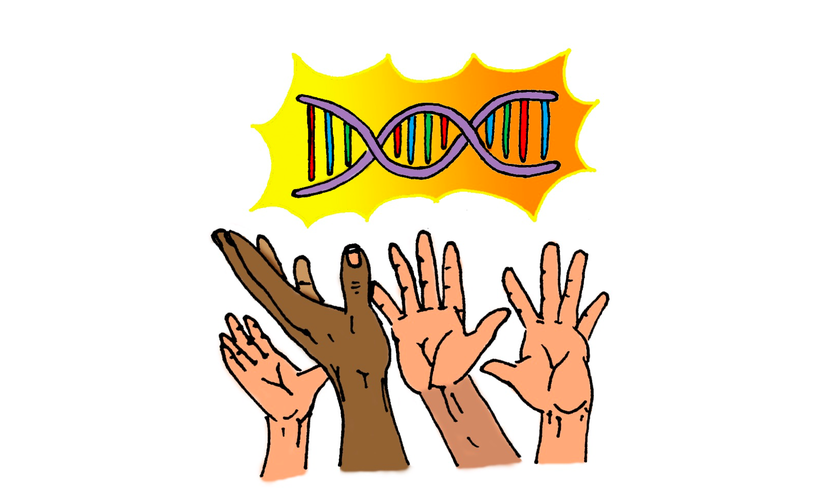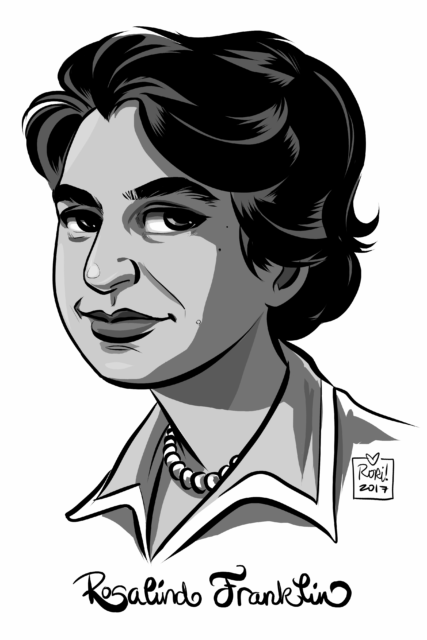Discovery of the double helix – the unknown competition

DNA. It’s the instruction manual for life. This genetic material holds the information which ranges from determination of hair colour and skin pigmentation to disease susceptibility and this is passed from generation to generation. This vital molecule has been investigated for over one hundred years and continues to be studied by many researchers across the globe today. While there is much left to know about DNA, one thing that has been established for over 50 years is the iconic, double helix structure. Francis Crick, James Watson and Maurice Wilkins were awarded the Nobel Prize in Physiology or Medicine for this fundamental discovery in 1962. However, this award still raises debate today. Some believe another scientist played a crucial part in this discovery and was also deserving of the prize.
To understand what contributed to the discovery, let’s take it back to the early 1950s…
A young scientist, Rosalind Franklin, had recently been awarded her PhD in physical chemistry and was beginning a research post at King’s College in London. Her job during this post was to establish and develop the X-ray crystallography unit there. X-ray crystallography is a method used to determine the molecular structure of a crystal. As crystals exist in many molecules – from rocks, to organic chemicals, and importantly, biological material, this method can be used widely1. When crystals are placed under an X-ray, beams from the X-ray are diffracted from the crystal – the angle and intensity of the beams can then be measured and used to determine the structure. Franklin was hired to work alongside Maurice Wilkins, a fellow scientist working on X-ray crystallography, as well as a PhD student, Raymond Gosling. It was a prosperous, collaborative relationship between Gosling and Franklin particularly and they quickly developed this technology to a standard that meant it could be utilised to determine the structure of our genetic material. Ultimately, photographs were taken of the DNA fibre. One famous image called Photo 51 led Franklin to propose that DNA was in a double helical structure.
During this time, a molecular biologist named James Watson visited Cambridge University where he met a physicist, Francis Crick, who was already researching the structure of DNA. They decided to collaborate and used model building as a way to work out the structure. This is a method used to determine how atoms piece together in 3D space. If you studied chemistry in school, you may be familiar with the ball and stick models used to determine structures of different chemicals. The ‘balls’ represent atoms and the ‘sticks’ represent chemical bonds. While easily accessible in the classroom today, in 1950, these were found in only the most prestigious labs2.
Watson and Crick based their model building on previous research from other scientists. This included knowledge that double helix structures existed in proteins and that DNA consisted of sugars, phosphates and a combination of 4 bases. Despite the previous research, the model building was very much trial and error with a triple helix appearing as a plausible structure along the way. One of the most significant pieces of data Watson and Crick utilised was the X-ray images taken by Franklin and Gosling. These images along with the model data allowed Watson and Crick to conclude DNA had the spiral-staircase-like double helix structure, with bases in the middle and a phosphate-sugar backbone. In 1953 their data was published in Nature Medicine alongside a paper showcasing the data generated by Franklin. Nine years later, Watson and Crick were awarded the Nobel Prize for this groundbreaking discovery along with Wilkins. However Franklin, who died in 1958, was not honoured.

Many are of the belief that Watson and Crick would have not made this crucial discovery without the work undertaken by Franklin and the famous Photo 51. So how did Watson and Crick get their hands on this significant piece of data?
Watson visited King’s College in 1952 where Wilkins revealed the famous photo 51. This was the final piece of the puzzle himself and Crick needed to support their model building data. In addition, a report written by Franklin about her data was given to Watson and Crick via two Cambridge colleagues. This was all the missing information required for Watson and Crick to correctly identify the structure of DNA.
As it still stands today, Nobel Prizes cannot be awarded posthumously, but many still believe Franklin should have been given recognition for her invaluable contribution to the award-winning research. While Watson and Crick successfully pulled together all the data, and Wilkins validated Watson and Crick’s model, should Franklin have been notified when colleagues passed her data report on to others? Was it unfair given that Franklin did not have access to the valuable model data? As she could not be recognised by the Nobel Committee, Watson and Crick should have properly acknowledged Franklin for the crucial X-ray image. Questions surrounding the behaviour and ethics of Watson and Crick continue to cause a divide.
Why do we care about this in 2019? This debate raises many issues that are very much relevant to scientists today. How important is multidisciplinary research? How open should we be with our data? And does the Nobel Prize correctly reflect the work behind the scenes?
This discovery exemplifies the large group of people with varying expertise that it takes to make such a significant discovery. It also highlights the many years it takes and the fact that everyone’s research is based on an earlier discovery by themselves or someone else. The discovery of the DNA structure was made due to knowledge acquired by chemists, biologists, physicists and others. Multidisciplinary research is just as important today as it was 70 years ago – we still have many questions to ask about human biology and disease which requires knowledge from many areas. At the moment, we are seeing a rise in multidisciplinary conferences and labs around the world with ‘hubs’ at research institutes popping up to bring people of different disciplines together in one place3. These hubs allow academics, industry representatives and clinicians to work together to tackle disease and other problems we face in society. As the requirement for multidisciplinary research increases, there is not only the need to improve infrastructure but also to address the issue of an ever increasing author list in publications. In recent years, a European committee met to tackle this issue. The consensus was that accreditation for work in a multidisciplinary project needs reviewing4. Ultimately, this committee provided some guidelines which should be implemented worldwide to ensure everyone is acknowledged for their contribution to a piece of research.
Another significant worry of many scientists, highlighted through this controversial discovery of the double helix, is being ‘scooped’. This simply refers to being beaten to the post by another scientist working towards the same research goal as you. In academia, being scooped is often in the form of someone else publishing findings in a journal before you do. The frequency of being scooped varies among disciplines and countries, but in areas of research that are incredibly saturated, such as cancer, the chance is more likely. While in order to get funding your research must be novel in some way, research labs from opposite sides of the world are often asking very similar questions. Depending on resources and funding, one group will reach an answer before another. Furthermore, a crucial part of a scientist’s career is travelling to conferences for the opportunity to showcase their own research and receive updates on the other research in their field. This is an incredible opportunity to network and learn from others, although it remains a source of anxiety for many.
At conferences, it is common for some researchers to show data that is not yet published. If someone from a small lab with limited funding provides a few pieces of essential information, a more prosperous lab could use this information, undertake a few experiments and publish before the other. In recent years, there has been an increase in open data and open research that some believe will reduce the threat of being scooped. Open research refers to publicly accessible software, funding and data. A new study has taken place with a view to understanding how open platforms cope with the risk of data being stolen and how researchers feel about this type of platform. The results show that being open with data most often requires trust from close peers and colleagues more than the wider research network. Additionally, this study shows that attitudes to research concerned with answering an important scientific question, and doing this in the correct way, lends itself more to successful open research as opposed to attitudes focused on publication or promotion5.
Also highlighted through this important piece of science history is the years of hard work which are required for a Nobel Prize. Up to three people can receive one award, however, the people honoured, while the original ideas may be their own, would not be able to make these award-winning discoveries without an entire team behind them. At the stage most people receive Nobel Prizes, they have their own research groups, commonly consisting of technicians, PhD students, research assistants and other post-doctoral researchers. This team carry out experiments and are involved in much of the optimisation and troubleshooting that is almost always required in any area of scientific research. While Nobel Prize winners are incredibly deserving of their awards, it is useful to keep in mind the many people it takes to reach that point6.
Thanks to Watson, Crick, Wilkins, Franklin, as well as numerous other scientists before them, we know how our DNA is structured. As is common throughout biology, structure relates to function and so this information has led to further revelations that have benefited science and health today. The story of this monumental discovery exemplifies the importance and potential result of collaboration in research and alludes to the consequences of not sharing data appropriately. In an ever-increasing competitive scientific environment with high publication pressure, hopefully scientists today remain encouraged to embark on collaborative research projects and continue to be vigilant and give recognition where it is deserved.
This article was specialist edited by Sarah Neidler and copy-edited by Gemma Donnelly.
References
- https://www.ncbi.nlm.nih.gov/pmc/articles/PMC1186895/
- https://eic.rsc.org/feature/the-rise-of-molecular-modelling/3007610.article
- https://www.imperial.ac.uk/strategy/foundations/multidisciplinary-research/
- https://www.scienceeurope.org/wp-content/uploads/2016/06/SE_LEGS_Careerpaths_Workshop_Report.pdf
- https://datascience.codata.org/articles/10.5334/dsj-2017-029/
- https://www.nobelprize.org/prizes/facts/nobel-prize-facts/










